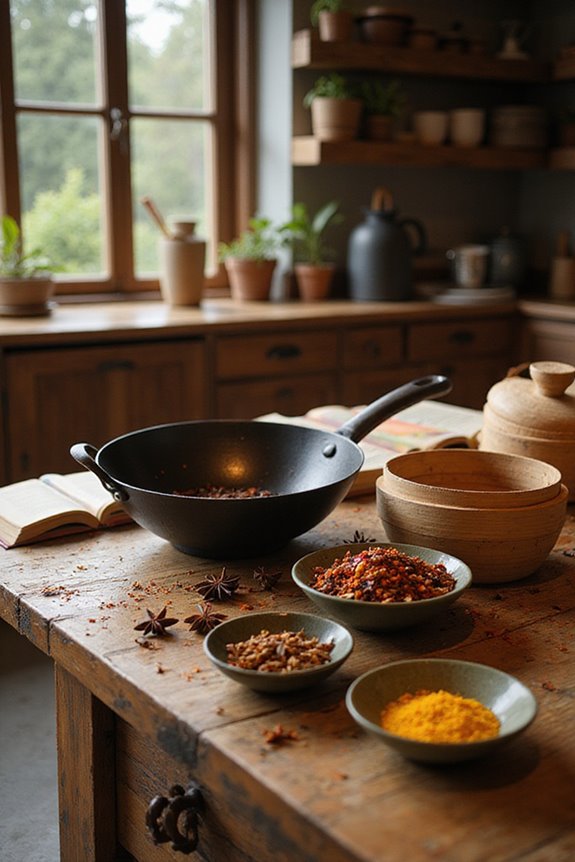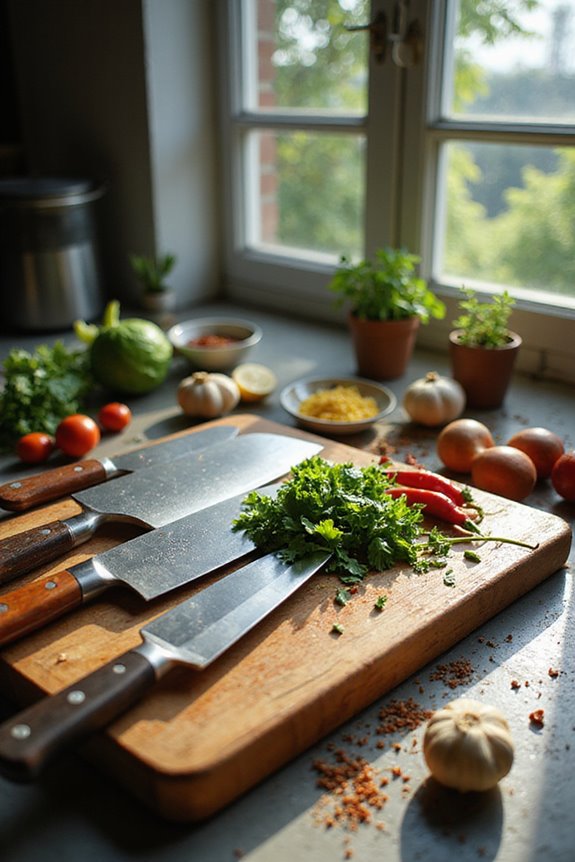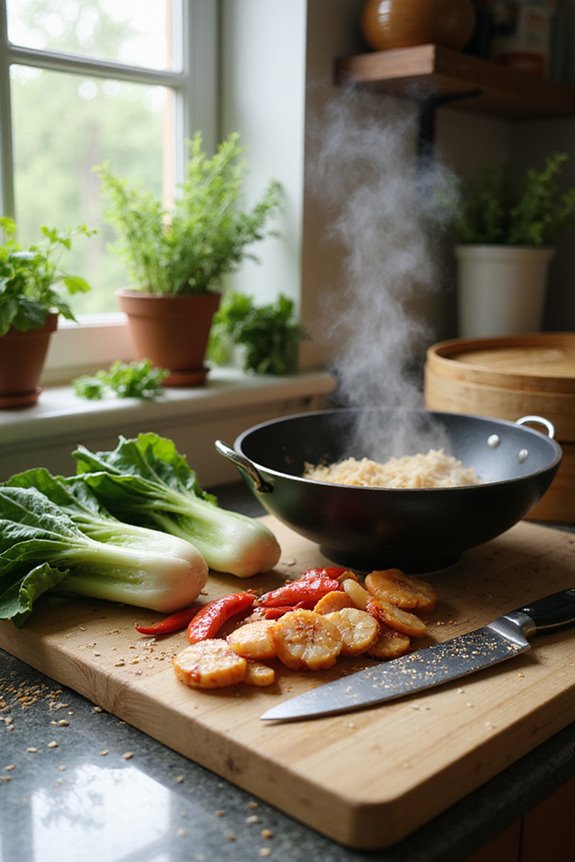As an Amazon Associate, we earn from qualifying purchases. Some links may be affiliate links at no extra cost to you. Although our opinions are based on curated research, we haven't used these products. Articles generated with AI.

5 Best Sustainable Landscape Designs to Transform Your Outdoor Space in 2025
To transform your outdoor space in 2025, consider these five sustainable landscape designs: prioritize native plants for local wildlife, use drought-resistant species, implement xeriscaping to minimize lawns, incorporate rain barrels for efficient irrigation, and utilize locally sourced materials to reduce your carbon footprint. These designs not only enhance beauty but also promote eco-friendly practices. By choosing the right elements, you can create a functional and attractive environment that supports biodiversity and soil health. Explore more innovative options ahead.
Key Takeaways
- Incorporate native plants for biodiversity, requiring less water and creating habitats for local wildlife in your landscape design.
- Utilize xeriscaping techniques by minimizing lawn areas and selecting drought-resistant plants for efficient water use.
- Install rain barrels and drip irrigation systems to enhance water conservation and promote efficient irrigation practices.
- Choose sustainable materials like locally sourced or recycled options, considering permeable surfaces in hardscaping for groundwater replenishment.
- Apply practical permaculture principles to preserve soil health, focusing on practices like cover cropping and reduced tillage for integrated ecosystem development.
Dogscaping: Creating the Perfect Backyard and Garden for You and Your Dog
Sale
Dogscaping: Creating the Perfect Backyard and Garden for You and Your Dog
- Used Book in Good Condition
- Barthel, Thomas (Author)
- English (Publication Language)
If you’re a dog owner looking to create a backyard that’s both beautiful and safe for your furry friend, “Sustainable Landscape Designs” is an excellent choice. This book emphasizes the importance of carefully selecting plants that won’t harm your dog. While some readers found the content lacking in thorough dog-proof ideas, it does provide practical dogscaping tips for enjoying outdoor time with pets. Visual inspiration abounds, showcasing designs that can enhance your yard. However, consider supplementing this resource with additional material to guarantee a diverse and aesthetic landscaping approach, ensuring your dog’s safety and happiness while maintaining your garden’s beauty.
Best For: Dog owners looking for practical landscaping ideas that prioritize safety and beauty for their pets.
Pros:
- Provides practical tips for creating a dog-friendly yard.
- Includes visual inspiration with photos of dog accommodating designs.
- Offers helpful advice on understanding dog behavior in landscaping plans.
Cons:
- Content may lack comprehensive dog-proof landscape designs.
- Some sections are unrelated, covering topics like vegetable gardening and dog training.
- Not all plant recommendations are pet safe, necessitating additional research.
Practical Permaculture Book
Sale
Practical Permaculture: for Home Landscapes, Your Community, and the Whole Earth
- Timber press or
- Language: english
- Book - practical permaculture for home landscapes, your community and the whole earth
“Practical Permaculture” stands out as an essential resource for anyone enthusiastic to embrace sustainable landscape designs, whether you’re a novice gardener or an experienced horticulturist. This guide presents clear, science-based principles and modernizes permaculture for today’s audience. You’ll learn to assess your specific site characteristics, set goals, and utilize design tools like zones and sectors effectively. With practical applications relevant even in colder climates, this book emphasizes actionable steps over theory. The high-quality illustrations and charts make concepts easy to digest, though its unavailability on Kindle limits access. It’s a great reference, often recommended for newcomers and seasoned practitioners alike.
Best For: “Practical Permaculture” is best for anyone interested in sustainable landscape design, from novice gardeners to experienced horticulturists seeking actionable guidance.
Pros:
- Thorough introduction: Provides a clear and science-based overview of permaculture principles that modernizes the subject for a contemporary audience.
- Accessible design tools: Offers easy-to-understand design tools and techniques that cater to both beginners and experienced practitioners.
- Practical application: Emphasizes real-world relevance and actionable steps, especially for those in colder climates.
Cons:
- Limited availability: The book is not available on Kindle, which may restrict accessibility for some readers.
- Weighty content: The wealth of information may be overwhelming for complete beginners without prior knowledge of permaculture.
- Focus on specific environments: Some techniques may be less relevant for regions with warmer climates or different ecological characteristics.
Think Like An Ecosystem: An Introduction to Permaculture and Landscape Design
Think Like An Ecosystem: An Introduction to Permaculture, Water Systems, Soil Science and Landscape...
- des Plantes, Amélie (Author)
- English (Publication Language)
- 198 Pages - 01/28/2022 (Publication Date) - Ecological Food Forest (Publisher)
For anyone enthusiastic to immerse themselves in the world of sustainable gardening, “Think Like An Ecosystem: An Introduction to Permaculture and Landscape Design” serves as an ideal starting point. This book offers accessible insights into permaculture, soil science, and water systems. You’ll find clear, practical tips to help develop integrated ecosystems in your garden. Structured with bullet points, it makes scanning easy. While some topics could benefit from further exploration, the guidance empowers you to contribute positively to your environment. With its focus on sustainability and efficiency, this book is perfect for beginner gardeners keen to create low-maintenance, productive outdoor spaces.
Best For: Beginner gardeners eager to learn about sustainable practices and integrate permaculture concepts into their outdoor spaces.
Pros:
- Provides clear and practical insights into permaculture and sustainable gardening techniques.
- Structured with easy-to-scan bullet points, making it user-friendly for readers.
- Empowers readers by alleviating misconceptions about permaculture and encouraging positive contributions to the environment.
Cons:
- Some readers may find the author’s tone somewhat preachy regarding certain values.
- Certain topics may lack depth and would benefit from further exploration in future editions.
- Visuals are presented in black and greyscale, which might limit the aesthetic appeal compared to color-printed alternatives.
The Encyclopedia of Grasses for Livable Landscapes
Sale
The Encyclopedia of Grasses for Livable Landscapes
- Used Book in Good Condition
- Hardcover Book
- Darke, Rick (Author)
“The Encyclopedia of Grasses for Livable Landscapes” stands out as an essential guide, especially if you’re a landscape designer or an enthusiastic gardener. This thorough reference showcases ornamental grasses, blending artistic design with horticultural insights. Each species appears alphabetically, accompanied by stunning photos, making it a practical resource for your projects. You’ll appreciate the design chapter, which emphasizes color, form, and line, helping you incorporate grasses effectively. While the detailed information may seem overwhelming for beginners, it’s invaluable for enthusiasts. However, keep in mind the need for width size information, which would enhance your planning process greatly.
Best For: Landscape designers and gardening enthusiasts seeking an in-depth understanding of ornamental grasses.
Pros:
- Offers a comprehensive and visually appealing reference on ornamental grasses.
- Provides design insights emphasizing color, form, and line for effective garden incorporation.
- Features detailed species information and care instructions beneficial for gardening enthusiasts.
Cons:
- Lacks width size information for grasses, which is crucial for effective planning.
- The level of detail may be overwhelming for beginner gardeners.
- Some users have reported readability issues on digital platforms.
The New American Landscape on Sustainable Gardening
Sale
The New American Landscape: Leading Voices on the Future of Sustainable Gardening
- Hardcover Book
- English (Publication Language)
- 255 Pages - 12/19/2025 (Publication Date) - Timber Pr (Publisher)
Sustainable Landscape Designs caters to environmentally conscious gardeners enthusiastic to cultivate thriving landscapes that respect nature. “The New American Landscape” offers insights from experts that cover critical sustainable gardening practices. It emphasizes the use of native plants, avoiding harmful fertilizers and pesticides, and adapting to climate change. In particular, consider how switching to drought-tolerant plants might not always lead to reduced water use. Instead, explore using reclaimed water for irrigation. With its engaging writing and enriching visuals, this book is a valuable resource for anyone interested in environmentally responsible gardening, from novices to seasoned green thumbs looking to expand their knowledge.
Best For: Environmentally conscious gardeners looking to implement sustainable practices in their landscaping efforts.
Pros:
- Emphasizes the use of native plants, enhancing local biodiversity.
- Provides clear, reader-friendly writing that makes sustainable gardening accessible to all skill levels.
- Includes comprehensive resource lists that guide further study and education on sustainable gardening practices.
Cons:
- Some critiques regarding the water-saving guidelines may lead to misunderstandings about water use.
- The emphasis on avoiding fertilizers and pesticides might not account for all gardening scenarios and specific plant needs.
- Readers may find some concepts challenging to apply without prior gardening experience.
Factors to Consider When Choosing Sustainable Landscape Design

When you’re planning a sustainable landscape design, it’s essential to take into account several key factors. You’ll want to assess the ecological impact, select native plants that thrive in your area, and implement water conservation techniques. Additionally, focusing on soil health and using sustainable materials can lead to a healthier, more resilient landscape.
Ecological Impact Assessment
Considering the intricate relationships within ecosystems, conducting an ecological impact assessment before implementing any landscape design is essential. This assessment evaluates how your design could affect local ecosystems, including plants, animals, and soil health. You’ll want to analyze biodiversity, water usage, soil composition, and the potential introduction of non-native species that can disrupt local habitats. Using metrics like species richness and abundance helps you determine the ecological value of your proposed design. The findings guide sustainable practices, ensuring you support local wildlife and minimize harmful chemical inputs. Don’t forget, regular monitoring after implementation is vital. It helps you track long-term impacts and make adjustments that can improve sustainability in your landscape.
Native Plants Selection
Selecting native plants for your landscape design makes a significant impact on sustainability and local ecosystems. These plants thrive in your area’s climate, needing less water and maintenance than non-natives. By choosing native species, you provide essential habitats and food for local wildlife, especially pollinators like bees and butterflies. Plus, native plants often resist pests and diseases better, reducing the need for chemical pesticides, which promotes a healthier garden environment. Incorporating them can also enhance biodiversity, attracting a variety of insects and birds. Additionally, their robust root systems help improve soil health, reduce erosion, and promote water infiltration, leading to a more sustainable landscape. Embracing native plants truly transforms your outdoor space.
Water Conservation Techniques
Choosing native plants not only supports local biodiversity but also sets the stage for effective water conservation techniques in your landscape design. You can implement xeriscaping, which minimizes lawn areas and uses drought-resistant plants, reducing water usage by up to 50%. Installing rain barrels allows you to collect and store rainwater, providing a sustainable irrigation source during dry spells. Consider utilizing drip irrigation systems—these deliver water directly to plant roots, cutting evaporation and runoff while potentially saving 60% more water than conventional sprinklers. Adding mulch in garden beds retains soil moisture and can decrease water evaporation by up to 70%. Finally, designing landscapes with permeable surfaces promotes groundwater replenishment, reducing your need for irrigation.
Soil Health Preservation
Soil health preservation plays an essential role in creating sustainable landscapes, as it directly impacts plant growth, nutrient availability, and ecosystem resilience. Healthy soil, rich in organic matter and microorganisms, enhances nutrient cycling and water retention, which reduces your reliance on chemical fertilizers. Incorporating practices like cover cropping and reduced tillage maintains soil structure, prevents erosion, and promotes carbon sequestration. You can also encourage soil health by using native plants, which foster beneficial relationships with local organisms and require less irrigation. Regular soil testing helps you identify nutrient deficiencies and pH imbalances, enabling informed decisions about your soil management strategies. By prioritizing soil health, you’re effectively fostering a thriving landscape that supports both plants and the environment.
Sustainable Materials Utilization
When designing a sustainable landscape, it’s crucial to take into account the materials you use, as they greatly affect both the environment and the longevity of your project. Start by selecting locally sourced materials to cut transportation emissions and boost local economies. Incorporate recycled options like reclaimed wood or repurposed stone, which not only reduce waste but also lessen your ecological footprint. For hardscaping, consider permeable surfaces to enhance water infiltration and mitigate runoff. Opt for organic materials, such as untreated wood and biodegradable products, as they’re less harmful. Finally, focus on durable materials; choosing those with longer lifespans minimizes frequent replacements and helps conserve resources, ensuring your landscape thrives sustainably for years to come.
Biodiversity Enhancement Strategies
To create a thriving landscape that supports biodiversity, you’ll want to integrate various native plant species, as they offer essential habitats and food sources for local wildlife. Layered plantings with diverse heights, textures, and blooming times enhance ecosystem resilience against pests and diseases. Consider adding water features like ponds or rain gardens, which attract beneficial wildlife and create a dynamic environment. Utilizing permaculture principles, such as companion planting and polycultures, not only improves soil health but also fosters valuable relationships among plants, insects, and microorganisms. Establishing wildlife corridors and buffers around your landscape can improve connectivity between habitats, allowing species to move freely and interact, ultimately promoting genetic diversity and a healthier ecosystem for all.
Seasonal Planting Considerations
Integrating seasonal planting considerations into your landscape design can greatly enhance the health and beauty of your outdoor space. Start by selecting plants that thrive in your local climate, as this guarantees they flourish all year. Knowing local frost dates is crucial; it helps you time when to plant annuals and perennials for maximum growth. Incorporate native plants, since they require less water and support local wildlife, enhancing biodiversity. Align your planting with natural seasonal cycles to improve soil health while reducing fertilizer use. Additionally, consider a staggered planting schedule, which allows for continuous blooms and harvests, making your landscape dynamic and visually appealing throughout changing seasons. Embrace these strategies for a thriving and sustainable garden.
Maintenance and Care Practices
Choosing sustainable landscape design involves not just selecting the right plants but also understanding the essential maintenance and care practices that come with them. Native plants thrive in local climates, requiring less water and fewer chemicals. You’ll find that mulching minimizes weeding and watering by retaining moisture and suppressing weeds. Regular maintenance, like seasonal pruning, helps plant health while reducing chemical needs. Embracing permaculture principles, such as companion planting, can cultivate self-sustaining ecosystems that need less attention over time. Additionally, using organic methods for pest control and fertilization enhances soil health and biodiversity, lightening your overall maintenance load. By considering these practices, you’ll create a sustainable outdoor space that’s both beautiful and manageable.
Frequently Asked Questions
What Are the Costs Associated With Sustainable Landscape Designs?
When you’re considering sustainable landscape designs, costs can vary widely. Upfront expenses might include native plants, efficient irrigation systems, and organic soil amendments, often ranging from a few hundred to several thousand dollars. Additionally, you’ll need to factor in maintenance costs, which can be lower over time due to the resilience of sustainable choices. Investing in durable materials and drought-resistant plants not only enhances beauty but also saves you money long-term, making it a wise decision.
How Can I Maintain a Sustainable Landscape Throughout the Seasons?
To maintain a sustainable landscape throughout the seasons, you’ve got to be proactive. Start with native plants that thrive in your climate. Regularly mulch to retain moisture and suppress weeds. Water deeply but less frequently, promoting healthy root systems. In winter, protect perennials with mulch or cover crops to prevent erosion. During spring, prune and fertilize appropriately to improve growth. By staying consistent with these practices, you’ll have a thriving landscape year-round.
What Plants Are Best for Attracting Pollinators in My Garden?
Have you ever wondered why some gardens buzz with life? To attract pollinators, consider plants like lavender, echinacea, and milkweed; they’re not just pretty, but provide essential food. Native flowers like bee balm and goldenrod also work wonders, drawing in bees and butterflies alike. Make sure to plant in clusters, as this encourages foraging. By incorporating these choices, you’ll create a thriving ecosystem that supports pollinators and beautifies your garden.
How Do I Create Native Habitats Within My Landscape Design?
To create native habitats in your landscape, start by selecting local plants that provide food and shelter for wildlife. Incorporate a mix of flowering plants, grasses, and shrubs native to your area. Design your garden with various layers, from ground cover to taller plants, ensuring vertical diversity. Adding water features can enhance habitat life. Finally, avoid pesticides, allowing beneficial insects to thrive while fostering a balanced ecosystem in your outdoor space.
What Are Some Common Mistakes in Sustainable Landscaping to Avoid?
When you’re planning sustainable landscaping, avoid overwatering your plants; it can lead to root rot. Don’t make the mistake of choosing non-native plants that require excessive care. Another common issue is using synthetic fertilizers and pesticides; they harm local wildlife and soil health. Finally, be cautious about ignoring mulch; it retains moisture and suppresses weeds. Focus on these areas, and you’ll build a healthy, vibrant ecosystem in your outdoor space.









